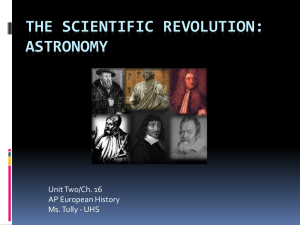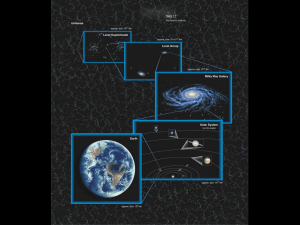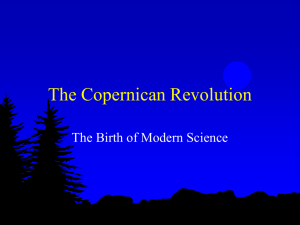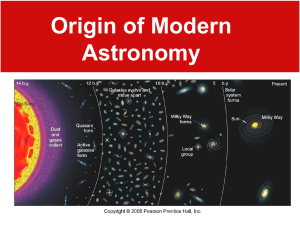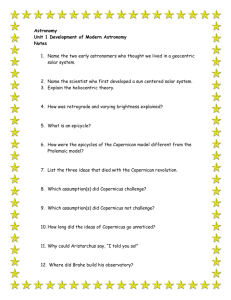Chapter 4 - The Origin of Modern Astronomy
advertisement
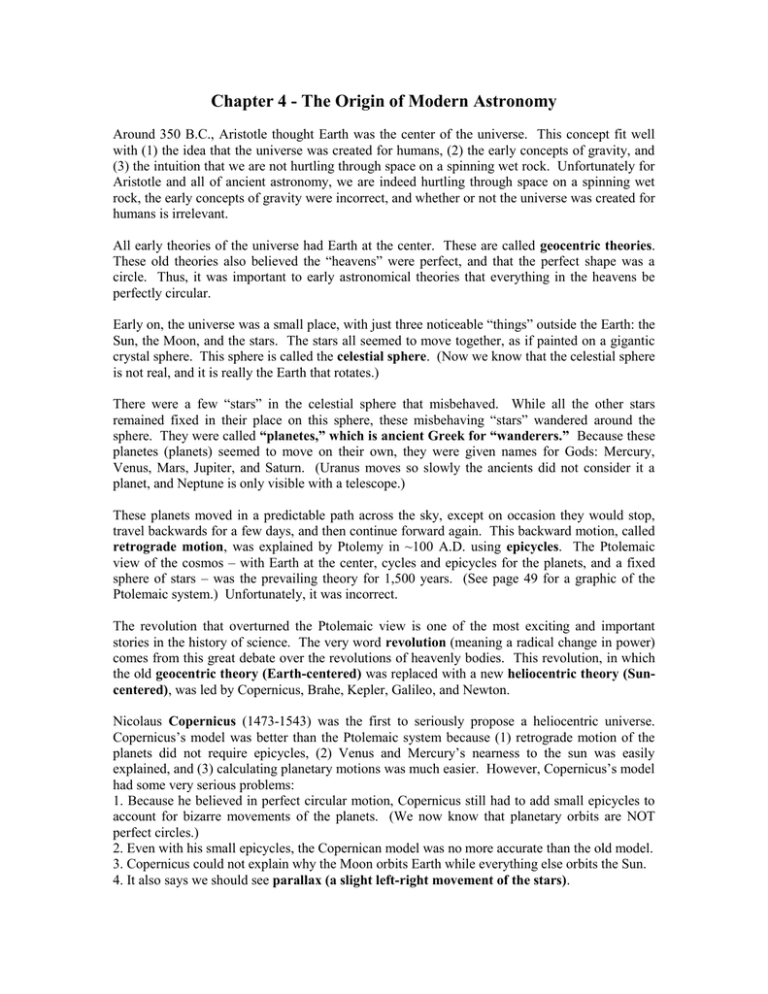
Chapter 4 - The Origin of Modern Astronomy Around 350 B.C., Aristotle thought Earth was the center of the universe. This concept fit well with (1) the idea that the universe was created for humans, (2) the early concepts of gravity, and (3) the intuition that we are not hurtling through space on a spinning wet rock. Unfortunately for Aristotle and all of ancient astronomy, we are indeed hurtling through space on a spinning wet rock, the early concepts of gravity were incorrect, and whether or not the universe was created for humans is irrelevant. All early theories of the universe had Earth at the center. These are called geocentric theories. These old theories also believed the “heavens” were perfect, and that the perfect shape was a circle. Thus, it was important to early astronomical theories that everything in the heavens be perfectly circular. Early on, the universe was a small place, with just three noticeable “things” outside the Earth: the Sun, the Moon, and the stars. The stars all seemed to move together, as if painted on a gigantic crystal sphere. This sphere is called the celestial sphere. (Now we know that the celestial sphere is not real, and it is really the Earth that rotates.) There were a few “stars” in the celestial sphere that misbehaved. While all the other stars remained fixed in their place on this sphere, these misbehaving “stars” wandered around the sphere. They were called “planetes,” which is ancient Greek for “wanderers.” Because these planetes (planets) seemed to move on their own, they were given names for Gods: Mercury, Venus, Mars, Jupiter, and Saturn. (Uranus moves so slowly the ancients did not consider it a planet, and Neptune is only visible with a telescope.) These planets moved in a predictable path across the sky, except on occasion they would stop, travel backwards for a few days, and then continue forward again. This backward motion, called retrograde motion, was explained by Ptolemy in ~100 A.D. using epicycles. The Ptolemaic view of the cosmos – with Earth at the center, cycles and epicycles for the planets, and a fixed sphere of stars – was the prevailing theory for 1,500 years. (See page 49 for a graphic of the Ptolemaic system.) Unfortunately, it was incorrect. The revolution that overturned the Ptolemaic view is one of the most exciting and important stories in the history of science. The very word revolution (meaning a radical change in power) comes from this great debate over the revolutions of heavenly bodies. This revolution, in which the old geocentric theory (Earth-centered) was replaced with a new heliocentric theory (Suncentered), was led by Copernicus, Brahe, Kepler, Galileo, and Newton. Nicolaus Copernicus (1473-1543) was the first to seriously propose a heliocentric universe. Copernicus’s model was better than the Ptolemaic system because (1) retrograde motion of the planets did not require epicycles, (2) Venus and Mercury’s nearness to the sun was easily explained, and (3) calculating planetary motions was much easier. However, Copernicus’s model had some very serious problems: 1. Because he believed in perfect circular motion, Copernicus still had to add small epicycles to account for bizarre movements of the planets. (We now know that planetary orbits are NOT perfect circles.) 2. Even with his small epicycles, the Copernican model was no more accurate than the old model. 3. Copernicus could not explain why the Moon orbits Earth while everything else orbits the Sun. 4. It also says we should see parallax (a slight left-right movement of the stars). 5. Most importantly, the Copernican model made the Earth a planet just like Venus or Jupiter. This idea was both scientifically confusing (why do apples fall to Earth and not the Sun? why don’t we feel like we’re flying through space?) and absolutely heretical (where is heaven and hell? why did God make other planets similar to ours?) Tycho Brahe (1546-1601) is most famous today for his accurate measurements of the cosmos. When Brahe was 25 years old, a new star appeared in the sky. (We now know that stars do not suddenly appear overnight. The astronomical event in 1572 was a supernova, not a new star.) Brahe decided that we needed better measurements of the cosmos to figure out what was really going on, so he built a tremendous observatory off the Danish coast, and took the best celestial measurements of his time. Johannes Kepler (1571-1630) was Brahe’s assistant and took over the observatory when Brahe died. Kepler is best known for Kepler’s three laws, which were: 1. Planetary orbits are ellipses, not circles! 2. A planet moves faster when it is closer to the sun in its orbit. (Equal areas in equal times.) 3. There is a relationship between a planet’s time to orbit the Sun and its distance from the Sun. Kepler’s planetary predictions, based on his theories and laws, were ~50 times more accurate than anyone before him. It finally looked like Ptolemy would be replaced! Galileo Galilei (1564-1642) did NOT invent the telescope, but he was the first astronomer to use this new invention to tackle the “problem” of planetary motions. The most important of Galileo’s early discoveries was four small planets orbiting Jupiter. (We now know these are Jupiter’s four largest moons: Io, Callisto, Ganymede, and Europa.) Never before had people seen an astronomical object that clearly did NOT orbit the Earth. Moreover, Galileo saw the full phases of Venus; in the Ptolemaic system, Venus will never be in gibbous or full phase! The old geocentric model was being replaced with the heliocentric model. Data was taking precedence over philosophy. But why do some things orbit the Sun, while others orbit Jupiter? If the Sun is the center of the universe, then why do cannonballs fall to Earth? Why are Kepler’s three laws true? Isaac Newton (1643-1727) solved all of these mysteries with one brilliant idea: gravity. Gravity says that every pair of objects are attracted to each other. Big objects attract more, and close objects attract more. Gravity explained… 1. why most things orbit the Sun (because it is so big!) 2. why the Moon orbits the Earth (because it is so much closer than the Sun!) 3. why the Earth wobbles in its orbit (because the Earth and Moon are really orbiting each other!) 4. why Kepler’s laws are true (they follow from the mathematics of gravity!) 5. why cannonballs fall to Earth (it’s the same gravity that keeps the Moon in orbit!) 6. that Brahe’s solar system model was the same as the old Copernican model (the new notion of gravity does not require a “center” of the universe!) Gravity elegantly explained how the Copernican model worked, and with the discovery of mutual universal gravitation, the Copernican revolution was complete. Nature and Nature’s Laws lay hid in Night. God said, “Let Newton be” and all was light. -Alexander Pope Homework Read chapter 4. Answer review questions 1, 3, 12, 15, and problem 1 on page 71.
